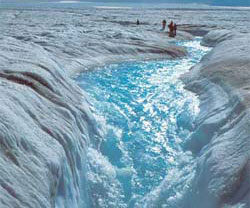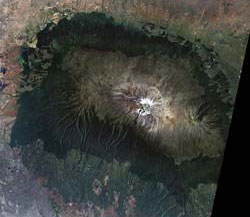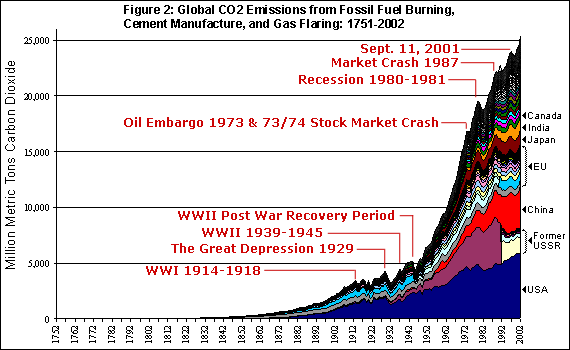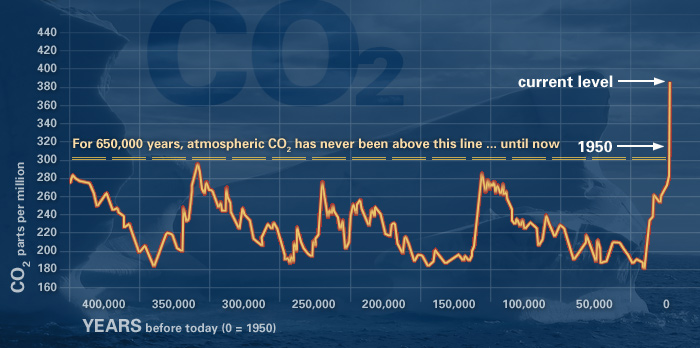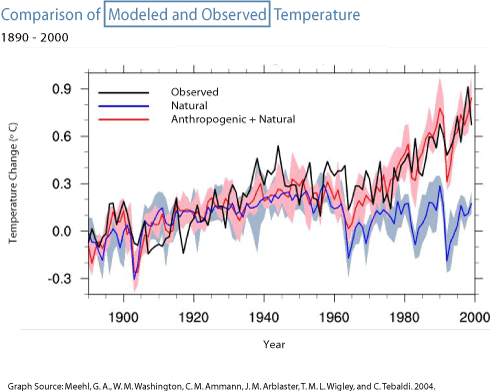Human Caused Global Warming
How do we know current global warming is human caused, or man made? Is global warming real, or a hoax? Consider the facts: the climate system is indicated to have left the natural cycle path; multiple lines of evidence and studies from different fields all point to the human fingerprint on current climate change; the convergence of these evidence lines include ice mass loss, pattern changes, ocean acidification, plant and species migration, isotopic signature of CO2, changes in atmospheric composition, and many others. The only identifiable cause explaining these changes with confidence is human influence and increased greenhouse gas emissions. Science has simply not found any other cause factor that can account for the scale of the recent increase in radiative forcing and associated warming.
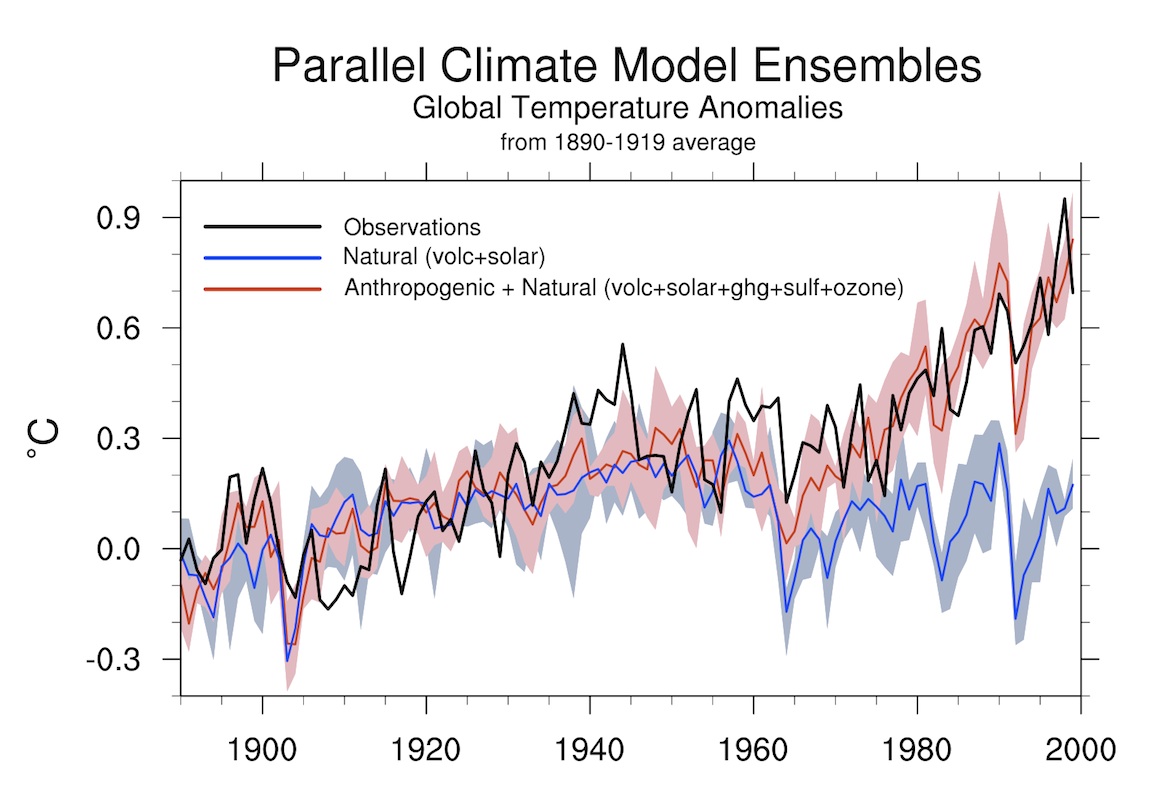
How do we know humans cause global warming?
Many are still asking is current global warming natural or human caused? The idea that global warming is natural is not an absurd question. In the natural cycle, global warming is natural. The better question is, ‘is current global warming natural’? There are multiple lines of evidence that point us to the origin of our current warming:
- Greenhouse gases trap infrared heat energy.
- The isotopic signature clearly shows that the extra CO2 in the atmosphere is from fossil fuels.
- We are no longer in the natural cycle. We have largely departed from the natural course of climate and there is no natural mechanism that explains it.
- The models and the observations match.
- There is simply no other mechanism that can explain the significantly altered climate path and the changes in the radiative forcing other than human causes.
To understand why ‘this current’ global warming is human caused and not natural cycle, one needs to get an idea of what the natural cycle is and what are the basic mechanisms that cause climate change in the natural cycle. The absolute essentials that you need to understand are the drivers:
To get a more detailed understanding of the mechanisms, you need to learn a little about:
The National Academy of Sciences, National Research Council, Board on Atmospheric Science and Climate Present:
‘Climate Change: Lines of Evidence’
Certain facts about Earth’s climate are not in dispute:
- The heat-trapping nature of carbon dioxide and other gases was demonstrated in the mid-19th century. Their ability to affect the transfer of infrared energy through the atmosphere is virtually certain based on the basic physics, measurements and observations and is also indicated in model confirmations. Increased levels of greenhouse gases must cause the Earth to warm in response.
- Ice cores drawn from Greenland, Antarctica, and tropical mountain glaciers show that the Earth’s climate responds to changes in solar output, in the Earth’s orbit, and in greenhouse gas levels. They also show that in the past, large changes in climate have happened very quickly, geologically-speaking: in tens of years, not in millions or even thousands.
The evidence for rapid climate change is compelling:
|
|
|
|
Republic of Maldives: Vulnerable to sea level rise
|
Sea level rise Global sea level rose about 17 centimeters (6.7 inches) in the last century. The rate in the last decade, however, is nearly double that of the last century. |
|
|
|
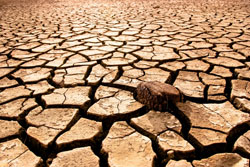 |
Global temperature rise All three major global surface temperature reconstructions show that Earth has warmed since 1880. Most of this warming has occurred since the 1970s, with the 20 warmest years having occurred since 1981 and with all 10 of the warmest years occurring in the past 12 years. Even though the 2000s witnessed a solar output decline resulting in an unusually deep solar minimum in 2007-2009, surface temperatures continue to increase. |
|
|
|
 |
Warming oceans The oceans have absorbed much of this increased heat, with the top 700 meters (about 2,300 feet) of ocean showing warming of 0.302 degrees Fahrenheit since 1969. |
|
|
|
|
Flowing meltwater from the Greenland ice sheet
|
Shrinking ice sheets The Greenland and Antarctic ice sheets have decreased in mass. Data from NASA’s Gravity Recovery and Climate Experiment show Greenland lost 150 to 250 cubic kilometers (36 to 60 cubic miles) of ice per year between 2002 and 2006, while Antarctica lost about 152 cubic kilometers (36 cubic miles) of ice between 2002 and 2005. |
|
|
|
|
Visualization of the 2007 Arctic sea ice minimum
|
Declining Arctic sea ice Both the extent and thickness of Arctic sea ice has declined rapidly over the last several decades. |
|
|
|
|
The disappearing snowcap of Mount Kilimanjaro, from space.
|
Glacial retreat Glaciers are retreating almost everywhere around the world — including in the Alps, Himalayas, Andes, Rockies, Alaska and Africa. |
|
|
|
 |
Extreme events The number of record high temperature events in the United States has been increasing, while the number of record low temperature events has been decreasing, since 1950. The U.S. has also witnessed increasing numbers of intense rainfall events. |
|
|
|
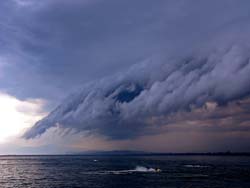 |
Ocean acidification The carbon dioxide content of the Earth’s oceans has been increasing since 1750, and is currently increasing about 2 billion tons per year. This has increased ocean acidity by about 30 percent. |
The Human Caused Global Warming Fingerprint
How do we know the increase in CO2 is human caused? There is an isotopic signature, like a fingerprint. CO2 that comes from natural sources has a low carbon-14 ratio. The pre-industrial atmospheric levels of CO2 were around 280ppm (parts per million). As of 2010 the amount is 390ppm. The extra 100ppm does not have the carbon-14 signature. The only other possible source that can account for the extra 100ppm is human industrial emissions of fossil fuels.
Stratosphere Cooling, Troposphere Warming
Suke Manabe and other scientists, when modeling the climate in the 1960’s at the Princeton Fluid Dynamics Laboratory, showed that increased CO2 would cause the lower atmosphere to warm and the upper atmosphere to cool (or warm less). This hypothesis has been observed in the data, which further supports the general accuracy of the models. Virtually all climate models show that this is what should happen, and the observed data shows that this is occuring.
Isoptope Evidence
When protons from GCRs (Galactic Cosmic Rays) collide with the nitrogen-14 (seven protons plus seven neutrons in the nucleus) in the air, carbon-14 is created (in addition to other isotopes such as beryllium-10) through a nuclear reaction:
14N + p → 14C + n
This means that carbon with a low isotope carbon-14 ratio must come from deep in the ground, out of reach of cosmic rays.
Furthermore, the ratio of O2 to N2 has diminished. This is expected from the increased combustion of fossil fuels, in which O2 combines with C to form CO2. The oceans have also become more acidic, leading to an increase in CO2 levels in both the atmosphere and the oceans.
Carbon Output as measured by the EPA:
Original Image Source: Environmental Protection Agency
The above chart from the EPA has been notated with specific events to show how events that impact social economics systems impacts growth of industrial greenhouse gases.
Ice Core Evidence
Source: https://climate.nasa.gov/evidence/
Attribution
Assessment of natural and anthropogenic (human-caused) influences indicate that the climate system would be relatively stable without industrial atmospheric influences such as greenhouse gases and aerosols.
Source: Attribution
It is reasonably clear that without anthropogenic forcings the climate would be closer to thermal equilibrium relative to the Holocene radiative forcing.
Summary
Since carbon-14 is created during exposure in the atmosphere, low isotope carbon-14 has not been subjected to atmospheric exposure and therefore must have come from underground. In other words, we dug it up, burned it, and now low isotope carbon-14 is in the atmosphere. That is how the two origins of carbon can be clearly identified, by the isotopic signature.
Said another way, low isotope carbon-14 is from fossil fuels, while the rest of the carbon has been in the natural cycle for longer periods. Longer expose times increase the C-14 in the molecule. Carbon that is stored and released through natural processes such as the normal seasonal carbon breathing that occurs in plant life has a longer atmospheric lifetime.
Links
- https://www.esrl.noaa.gov/gmd/infodata/faq_cat-3.html#5
- https://ipcc-wg1.ucar.edu/wg1/FAQ/wg1_faq-7.1.html
- https://www.epa.gov/climatechange/emissions/globalghg.html
- https://www.epa.gov/climatechange/emissions/co2_human.html
- https://www.scienceinschool.org/2008/issue8/climate/
- https://en.wikipedia.org/wiki/Isotopic_signature
- How do we know that recent CO2 increases are due to human activities?
- Related content
- Climate Models
- Weather v. Climate


